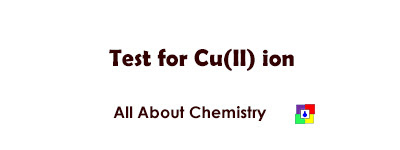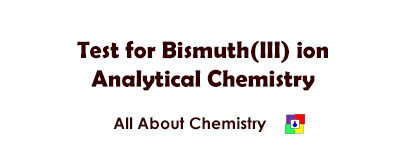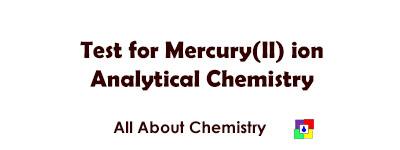1.Hydrogen sulphide test:
When hydrogen sulphide gas is passed through the acidic sample solution, a black ppt is obtained. This ppt is soluble in Conc nitric acid.
Cu2+ + H2S → CuS↓ + 2H+
3CuS + 8HNO3 → 3Cu2+ + 6NO3– + 2NO + 2H2O
2. Ammonia test:
When ammonium hydroxide solution is added, initially a pale blue ppt is obtained which dissolves in excess to form an inky blue solution.
2Cu2+ + SO42- + 2NH3 + 2H2O → Cu(OH)2.CuSO4 ↓ + 2NH4+
Cu(OH)2.CuSO4 + 8NH3 → 2[Cu(NH3)4]2+ + SO42- + 2OH–
3. Sodium hydroxide test:
When sodium hydroxide solution is added, a blue ppt is obtained which is insoluble in excess.
Cu2+ + 2OH– → Cu(OH)2 ↓
In the presence of tartaric acid or citric acid, instead of the ppt, an intense blue solution is formed.
4. Potassium iodide test:
When potassium iodide solution is added, white ppt is formed. But due to the formation of triodide ion, intense brown colour is formed. Adding an excess of sodium thiosulphate to the solution, the white ppt become visible.
2Cu2+ + 5I– → 2CuI↓ + I3–
I3– + 2S2O32- → 3I– + S4O62-
5. Potassium ferrocyanide test:
In neutral or acid medium, potassium ferrocyanide solution, produce a reddish-brown ppt , which dissolves in ammonia solution to produce a dark blue solution and with sodium hydroxide solution, a blue ppt is formed.
2Cu2+ + [Fe(CN)6]4- → Cu2[Fe(CN)6]↓
Cu2[Fe(CN)6] + 8NH3 → 2[Cu(NH3)4]2+ + [Fe(CN)6]4-
Cu2[Fe(CN)6] +4OH– → 2Cu(OH)2↓ + [Fe(CN)6]4-
6. Potassium thiocyanate test:
When potassium thiocyanate solution is added, a black ppt is formed, which decompose slowly to form white ppt.
Cu2+ + 2SCN– → Cu(SCN)2↓
Cu(SCN)2 → 2CuSCN ↓ + (SCN)2
7. α-Benzoinoxime test:
When α-Benzoinoxime solution is added, a green ppt is obtained.
8. Salicylaldoxime test:
When Salicylaldoxime solution is added, a greenish-yellow ppt is obtained.
9. Rubeanic acid test:
When rubeanic acid is added, a black ppt is obtained.















